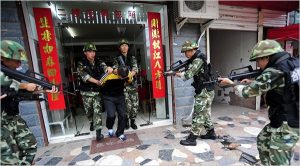Memo #88
By Major Thomas G. Nielsen and Dr. Liselotte Odgaard (ifs-61 [at] fak.dk)
 Separatist riots in Tibet in 2008 and in Xinjiang in 2009 demonstrated that Chinese authorities may be efficient at riot control. But the protests also indicate that China has not addressed the root causes of recurring ethnic unrest and deteriorating loyalty towards the Chinese regime among Tibetans and Uyghurs.
Separatist riots in Tibet in 2008 and in Xinjiang in 2009 demonstrated that Chinese authorities may be efficient at riot control. But the protests also indicate that China has not addressed the root causes of recurring ethnic unrest and deteriorating loyalty towards the Chinese regime among Tibetans and Uyghurs.
Counterinsurgency is not only about eradicating insurgents. It also aims at de-linking the insurgents from the local population by undertaking societal and institutional reform. Chinese counterinsurgency usually achieves the first objective, but not the second.
China focuses on maintaining physical security and stability by means of police and public security officials, using the People’s Liberation Army as a last resort. This approach has successfully maintained physical security by terminating large-scale violence and protecting political authorities.
The downside to the strategy is that societal and institutional reform is crowded out. Tibetan and Uyghur minorities question China’s entitlement to rule over them because their demands for achieving greater status, prosperity, and influence are not met. The pressures on ethnic minorities for trading in cultural distinctiveness with social opportunity in China are illustrated by the inclination of Tibetans and Uyghurs to adopt Han Chinese names to conceal their genealogical inheritance.
The unequal economic opportunities available to ethnic minorities compared to Han Chinese are demonstrated by the absence of Tibetans and Uyghurs in positions of decision-making power in profitable economic enterprises. The minimal political influence of non-Han Chinese is indicated by the lack of cooperation between Chinese officials and local Tibetan and Uyghur leaders with influence among their ethnic kin.
One explanation of the problems of Chinese counterinsurgency is the assimilationist traits of Chinese nationalism. These engender a uniform concept of the cultural practices of the Chinese nation that is incompatible with ethnic pluralism. Another explanation is the bias towards vertical coordination within China’s political system.
This structure allows security agencies to carry out their part of counterinsurgency efficiently. But horizontal coordination is poor between security agencies and agencies responsible for societal and institutional reform. This in turn prevents China from addressing the concerns of ethnic minorities that continue to fuel discontent.
About the Authors:
Major Thomas G. Nielsen is an analyst at the Royal Danish Defence College.
Dr. Liselotte Odgaard is an associate professor at the Royal Danish Defence College, and a research associate on the East Asian Peace program, Department of Peace and Conflict Research, Uppsala University, Sweden.
Links:
- Counterinsurgency Warfare: Theory and Practice (Book by David Galula)
- Countering Global Insurgency, The Journal of Strategy Studies, Volume 28, Issue 4, August 2005
- China Approves Law Governing Armed Police Force, New York Times, August 2009
- Does China’s Counterinsurgency Strategy Alleviate or Exacerbate Conflict in Tibet and Xinjiang? (Paper presented at the Association for Asian Studies and International Convention of Asia Scholars, March 31 to April 3, 2011 by Liselotte Odgaard and Thomas G. Nielsen)
Related Memos:
- Our collection of Memos on the Origins of Social Protests in China
